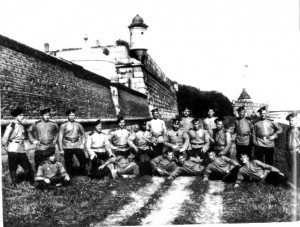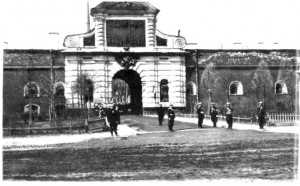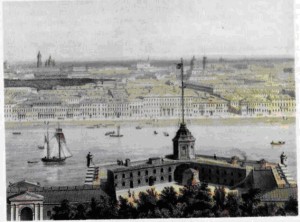During the War of 1812 the main force of the invading French army under the Emperor Napoleon I was directed at Moscow. However, preparations were made in the northern capital as well, and the St Petersburg Fortress was once again made battle-ready.
After a period of relative quiet in the late eighteenth and early nineteenth centuries, interest in the fortress as a strategic point was reawakened by the Emperor Nicholas I who ruled Russia from 1825 to 1855 and dabbled in the art of military engineering. In 1826 Nicholas I ordered that the fortress be classified as a first-class citadel, thus making it the main fortress in Russia. In 1827, according to plans approved by the Emperor, work was begun to update all the defensive structures located on Fortress Island. This work continued until 1840 and went on simultaneously with the rebuilding of the fortifications of Crohnstadt and its outlying forts. Thus, during the second quarter of the nineteenth century all the systems of permanent fortified structures in the eastern part of the Gulf of Finland were being updated. Marking the completion of work on the modernization of the defensive structures of Fortress Island, as it were, in September 1840, large-scale war manoeuvres took place in St Petersburg, during which an imitation storming of the fortress from its northern side was successfully repelled.
Nevertheless, the condition of the kronwerk fortifications remained unsatisfactory throughout the 1830s. In 1849 Nicholas I approved a plan drawn up at his direction which provided the construction of a three-storey stone defence arsenal within the kronwerk, and the work was commenced in the next year. The battle might of this arsenal surpassed all of the fortress bastions, and it took on the defence functions of the Empress Anna Bastion. Subsequently, in 1852, the Emperor confirmed a plan for rebuilding and reinforcing the old fortifications of the kronwerk. In the autumn of 1853 war between Russia and Turkey broke out, and England and France soon joined in against Russia (this war, which ended in 1856, was called the Crimean War, since the main military theatre was the Crimea Peninsula). And thus once again the St Petersburg Fortress went on battle alert, but didn’t have the opportunity to fire at its opponents since the approach to the Neva delta by English and French vessels entering the
Gulf of Finland was deterred by Russian mines. In 1855 Nicholas I died.
His successor, Alexander II, was much less keen on the fortress as a military object, and in 1856 it was decided not to carry out most of the work that had been provided for under the plan signed in 1852. Some of the stone from the old dilapidated kronwerk fortifications was hauled away and within the period of 1874—77, in the interest of freeing space for artillery warehouses, the eighteenth-century fortifications were almost completely destroyed. The only remaining trace is a significant depression and raised area corresponding to the rampart which had once stood there. With regard to the glacis which surrounded the kronwerk on the east, north and west, it is worth mentioning that the Ministry of Finance, which dealt with this part of St Petersburg Island during the reign of Nicholas I, desiring to somehow improve its appearance, began in 1842 to lay out a park on the glacis, naming it the Alexander Park in honour of Nicholas I’s brother, Alexander I.

In 1865 a zoological park opened in the western part of the former glacis (now the Leningrad Zoo). In 1900 in the Alexander Park the Folk House was opened (subsequently this building was added onto many times, recon-structed, and changed owners). In 1906 the Orthopedic Institute (today the Vreden Institute of Traumatology and Orthopedics) was opened in the park and in 1911 a monument dedicated to the sailors of the destroyer Steregushchy, which was sunk during the Russo-Japanese War of 1904—5, was installed. Back on Fortress Island in the mid-nineteenth century the gates in the St Alexei Ravelin were closed up, and in 1874 the St Nicholas Gate was widened, and both facades were redone. During the period beginning in the mid-nineteenth century and including the beginning of the twentieth century, almost all (he curtain walls were rebuilt from two-storey into one-storey structures. In 1880—82 the canal traversing the island was filled in with building refuse. In 1889—92 the moat in front of the St Peter Curtain Wall was filled in, and in 1893 the same was done with the moat in front of the Vasilyevsky Island Curtain Wall.
In 1892 work commenced on the construction of a permanent bridge (the Trinity, today Kirov Bridge) extending from the left bank of the Neva to St Petersburg Island. The floating bridge which had earlier joined the two river banks at this point was temporarily moved downstream during the construction period and installed so that it would lead to the fortress itself. In order to provide a thoroughfare through the fortress the grates were removed from the batardeaus near the Peter I and Peter II Bastions, a roadbed was laid over the filled-in moat in front of the St Peter Curtain Wall, and across the Kronwerk Strait another temporary wooden bridge was built.

After the beginning of World War I in 1914, and in connection with the official renaming of St Petersburg to Petrograd, the fortress as well came to be called the Petrograd Fortress. As the battle-field was distant from the northern Russian capital, the role that the fortress played was limited to receiving a few groups of war prisoners.
So the military history of the St Petersburg Fortress in pre-revolutionary Russia was quite unusual. The fortress on more than one occasion prepared for battle, it was rebuilt, armed, reinforced, but the enemy never once got close enough to be within its firing range. Throughout its pre-revolutionary history the St Petersburg Fortress never was exclusively a military object.



